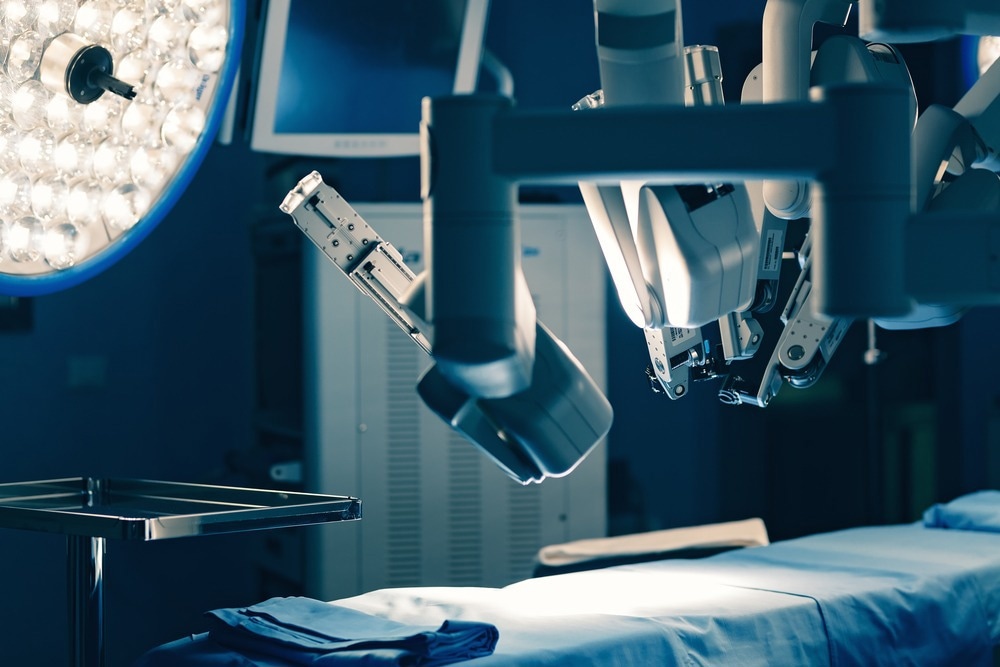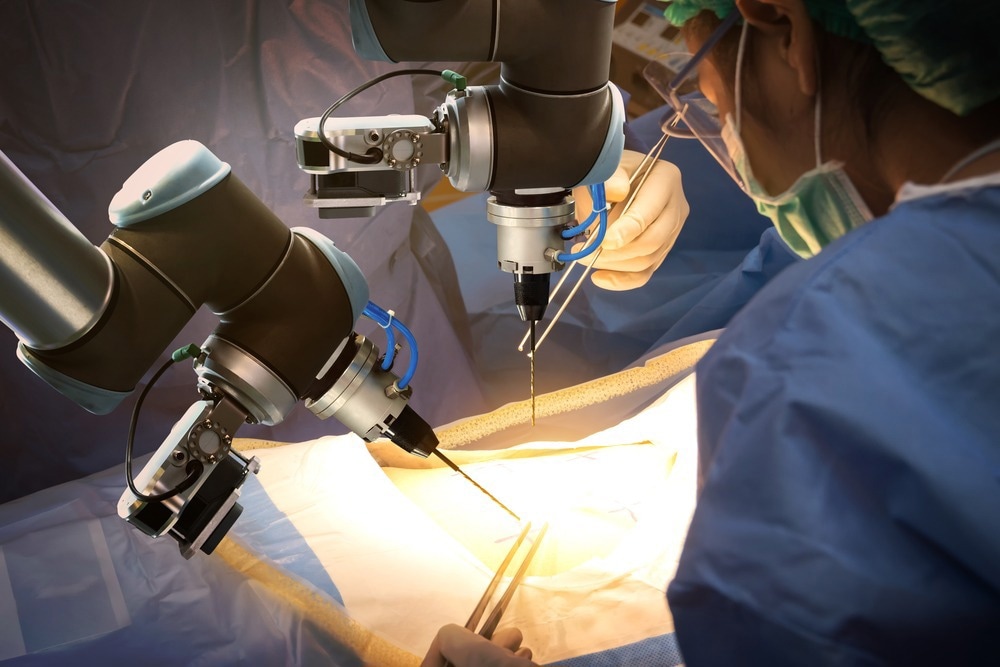The military, however, began to realize that the “golden minute” was more appropriate, and rather than aiming to bring wounded soldiers to the closest mobile army surgical hospital (MASH), they sought methods of bringing the operating room to the soldier. At this time, the first prototype of the first surgical robot was established – the Green Telepresence System, founded in 1946.
Surgical robots have rapidly become commonplace in operating theaters around the world in a short space of time. The da Vinci Surgical System (Intuitive Surgical Inc., Sunnyvale, CA) was released in 1999 and gained FDA approval the following year, marking the beginning of the surgical robot revolution. In the same era, the ZEUS was also launched and became the first commercially available surgical robot to complete transatlantic surgery.
Today the da Vinci Surgical System remains the most commonly used robotic surgery system in the world. However, it has evolved since its launch, allowing for greater surgical capabilities and supporting a number of surgical applications. In addition, numerous other systems have become available on the market.

Image Credit: MAD.vertise/Shutterstock.com
Applications Areas of Surgical Robots
In the relatively short amount of time that surgical robots have become widespread in global operating theatres, the number of applications in which they are leveraged has expanded greatly. Surgical robots are already used in many surgeries, including colorectal surgery, hepatobiliary surgery, gastric surgery, bariatric and antireflux surgery, endocrine surgery, cholecystectomy, and hernia repair, among others.
Additionally, several trends have emerged in research and development of surgical robots. For instance, robotic surgery can now be implemented on the nanoscale level with nanorobotic surgery.
With the advent of this branch of robotic surgery, surgeons can precisely carry out minimally invasive surgeries, including vascular surgery and neurosurgery. Nanorobotic surgery is also becoming increasingly important to cancer therapies.
Telerobotics was one of the first applications of robotic surgery. Back in 2001, surgeons in New York completed a laparoscopic cholecystectomy on a patient located in Paris with the ZEUS system. Since then, patients worldwide have benefited from access to world-class surgeons regardless of their physical location.
Telerobotics allows surgeons to operate remotely on a patient, bringing the world’s leading specialist surgeons to patients wherever they are in the world. This application is also vital to spreading knowledge and helping surgeons develop their expertise.
Robotic Surgery Unlocks a New Era of Medicine
Video Credit: Freethink/YouTube.com
Recent Developments in Surgical Robots
The field of surgical robots is rapidly developing, with a number of advancements occurring each year, which is helping to further develop the applications of the technology. Automated surgery is one current hot topic in the field of surgical robots, where much research is currently focused. In 2022, scientists at Johns Hopkins University developed a robot capable of performing laparoscopic surgery automatically without the need for a guiding hand of a human. The study was conducted on pig tissue and opened the door to fully automated surgery on humans.
In addition to the automation of robotic surgery, research and development are overcoming the limitations of remote surgery conducted by surgical robots. Although remote surgery is a huge benefit of surgical robots and is being increasingly conducted worldwide, such surgeries often require large robots (sometimes occupying an entire room), preventing the technology from being adopted in all locations.
Now, scientists have developed a surgical robot the size of a tennis ball that, in studies, has been proven to be significantly better than manually operated tools in delicate mock-surgical procedures.
Finally, the integration of artificial intelligence (AI) has emerged as another hot topic in surgical robots. As the field of AI matures, scientists are leveraging this in other sectors of science. Surgical robots are beginning to increasingly benefit from this technology, which is helping them overcome some of its limitations. For example, scientists at Nagoya City University have recently demonstrated how AI-enabled surgical robotics may bridge this skill gap that is limiting the use of a vital renal procedure used to treat kidney stones (percutaneous nephrolithotomy).

Image Credit: Zapp2Photo/Shutterstock.com
Current Global Market of Surgical Robots
The current global market for surgical robots was valued at around $3.6 billion in 2021. The market is predicted to grow rapidly between 2022 and 2030, expanding at an impressive CAGR of 19.3%.
This rapid growth will be driven by several factors. First, there is an increasing global shortage of physicians and surgeons, which is driving the demand for remote and automated surgeries. In addition, there has been an increasing level of investment in this sector, which will help fund research and development. Finally, there is a growing prevalence of certain diseases that particularly benefit from surgical robotics, such as bone degenerative diseases.
Currently, North America holds the largest share of the market, accounting for 50% of revenues in 2021. This is followed by Europe, Asia Pacific, and Latin America. In terms of growth, it is predicted that the Asia Pacific region will potentially experience the fastest growth rate between 2022 and 2030, with the growing patient population and increasing use of automated surgical instruments driving this growth. Additionally, awareness of advanced medical technology in this region is also spreading, further helping boost market growth in Asia Pacific.
Some key players in the industry include Stryker Corporation, Medrobotics, Smith & Nephew, TransEnterix Surgical, Inc., Renishaw plc., Intuitive Surgical, Medtronic, THINK Surgical, Inc., and Zimmer Biomet, among others.
Future Directions of Surgical Robots
As discussed above, the trends of miniaturization, automation, and integration of AI are currently shaping progress in the surgical robot market. In the coming years, we will likely see these trends continue to shape the market's direction, particularly as demand for these factors is currently acting as a major market driver.
As AI and nanotechnology mature further, we will likely see these advancements filter through into the surgical robot market, with more applications arising and potentially overcoming more limitations of current surgical robots.
Final Thoughts
The surgical robot market has great potential to grow and develop due to increasing demand and the increasing sophistication of related technologies such as AI and nanotechnology. We will likely see novel applications of surgical robots emerge over the coming years, as well as advancements to current applications so as automated and remote surgeries.
References and Further Reading
Barrera, R., (2018). The Surgical Robot: Applications and Advantages in General Surgery. Surgical Robotics,. https://www.intechopen.com/chapters/55313
George, E., Brand, T., LaPorta, A., Marescaux, J. and Satava, R., (2018). Origins of Robotic Surgery: From Skepticism to Standard of Care. JSLS : Journal of the Society of Laparoendoscopic Surgeons, 22(4), pp. e2018.00039. https://www.ncbi.nlm.nih.gov/pmc/articles/PMC6261744/
Saeidi, H., Opfermann, J., Kam, M., Wei, S., Leonard, S., Hsieh, M., Kang, J. and Krieger, A., (2022). Autonomous robotic laparoscopic surgery for intestinal anastomosis. Science Robotics, 7(62). https://www.science.org/doi/10.1126/scirobotics.abj2908
Surgical Robots Market Size, Share & Trends Analysis Report By Application (Orthopedics, Neurology, Urology, Gynecology), By Region (North America, Europe, Asia Pacific, LATAM, MEA), And Segment Forecasts, 2022 - 2030 [online]. Grand View Research. Available at: https://www.grandviewresearch.com/industry-analysis/surgical-robot-market
Suzuki, H. and Wood, R., (2020). Origami-inspired miniature manipulator for teleoperated microsurgery. Nature Machine Intelligence, 2(8), pp. 437-446. https://www.nature.com/articles/s42256-020-0203-4
Taguchi, K., Hamamoto, S., Okada, A., Sugino, T., Unno, R., Kato, T., Fukuta, H., Ando, R., Kawai, N., Tan, Y. and Yasui, T., (2022). A Randomized, Single-Blind Clinical Trial Comparing Robotic-Assisted Fluoroscopic-Guided with Ultrasound-Guided Renal Access for Percutaneous Nephrolithotomy. Journal of Urology, 208(3), pp. 684-694. https://pubmed.ncbi.nlm.nih.gov/35549460/
Disclaimer: The views expressed here are those of the author expressed in their private capacity and do not necessarily represent the views of AZoM.com Limited T/A AZoNetwork the owner and operator of this website. This disclaimer forms part of the Terms and conditions of use of this website.